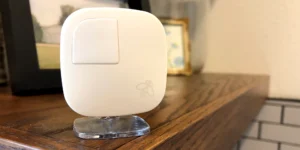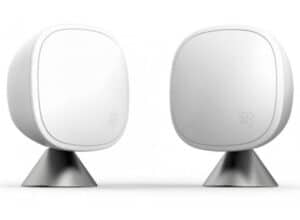How Ecobee Room Sensors Work?

We all tend to be curious about how stuff that could save us money, time and energy work. And our curiosity is definitely spurred by the thought of How Ecobee Room Sensors Work and whether they actually save us energy bills?
You might have also heard that Ecobee thermostats work better with room sensors. And, yes! A smart thermostat gets one hell of an upgrade with room sensors! So, how do these sensors work?
Smart thermostats are a great way to heat, cool, and manage your home’s temperature all from the convenience of your iPhone or iPad. They are not a recent find, however, as they’ve been making giant strides in the market for years now; however, Ecobee has been a regular No. 1 item when it comes to the topic of the best smart thermostats. A major reason why Ecobee always comes out on top is as a result of its room sensors.
I’ve been an Ecobee user for a while now, and with my knack for DIYs, I’ve learned a lot about these amazing room sensors. I will be sharing with us, as clearly as possible, how the Ecobee room sensors work. But first…
What Are Ecobee Room Sensors?
Ecobee room sensors are an auxiliary addition you can link to your Ecobee smart thermostat to give the thermostat the ability to recognize the temperature of the various rooms in your house.
Now, the room sensors not only detect a room’s temperature, but they are also equipped with motion sensors, such that it can tell when there’s someone in that room.
What Makes Room Sensors So Useful?
When you install a smart thermostat to a room and assign a temperature to it, the thermostat, on its own, is only able to monitor the area directly surrounding it. This implies that while the temperature in your sitting room where the thermostat your could be a toasty 70 degrees, the guest bedroom upstairs could be at a scorching 75 degrees. The occurrence of hot or cold spots in your house can be disturbing and makes staying in certain rooms uncomfortable.
Room sensors, on the other hand, reveal to you the temperature of every room you place them in. This implies that you have a better picture of what the temperature is over your whole house.
The Ecobee smart sensors work well with smart thermostats that support voice control such as the Ecobee 3, Ecobee3 Lite and Ecobee4. Should you eventually decide to upgrade your thermostats, these sensors can be quickly unpaired and coupled into the new thermostat.
How do Ecobee Room Sensors work?
Automatic dampers on HVAC systems aren’t a common feature in most houses, implying when the heat or the AC turns on, it pumps air through the entire house. Ecobee understands this situation, and one of the major purposes of the room sensor is to give the thermostat an idea on how even-out the temperature in your house as it tries to eliminate those hot and cold spots.
The Ecobee temperature sensor has a +/- 1.0F accuracy and is programmed to provide readings every 15 seconds. It will use the previous two values and average them into the current reading.
– Ecobee Support
As a practical example, you’ve placed a room sensor in your guest room, and it’s currently 73 degrees, but your smart thermostat in the sitting room is reading 70 degrees. Your Ecobee smart thermostat will then aim at distributing the heat around your house to about 71 degrees (as a middle ground). The more room sensors you have, the more informed your Ecobee thermostat is to estimate a comfortable average.
Ecobee Room Sensor: Specifications

Viewing Angle
The Ecobee room sensors include a horizontal scope of approximately 120 degrees, and a vertical scope of approximately 25-30 degrees. Furthermore, they can detect motion within a 15-feet radius. An essential thing to keep in mind here is that the sensors will not be set off by every tiny motion in the room.
The motion sensors cannot detect how far an object is from itself, implying that persons or objects which are closer have a much greater impact on the sensor than objects that are further away. Therefore, it will take a much larger object to trigger the sensors at 15 feet than it would at 15 inches.
Battery
The Ecobee smart room sensors are fuelled by a CR2032 coin cell battery. The battery is reportedly able to power the sensor for 18-24 months. Originally, Ecobee marketed a battery life of 4 years, but they amended the figures after a few evaluation sessions. Ecobee says the battery life depends on factors like the rate of movement and distance between sensor and thermostat).
Communication
Ecobee room sensors make use of 915MHz radio waves for safe, energy-efficient communication with the Ecobee thermostat. The sensors have a maximum communication reach of 45 feet, however, physical barriers such as thick walls and floors may cause their efficiency to drop. Note that other devices working on 915MHz frequency (for example baby monitor or cordless phones) can reduce the range.
When Ecobee remote sensors are located too far from the thermostat, they become inaccurate or display incorrect readings. You should place sensors within the advertised range to ensure proper communication between the sensors and the thermostat.
Ecobee Room Sensor: Features

All sensor options and features can be accessed from the sensor menu. The sensor menu can be accessed from all three device types: mobile app, web app, and the Ecobee thermostat.
Sensor Participation
The remote sensors come with three default comfort profiles: Home, Away, and Sleep. With the sensor participation feature, you get to pick which sensors to use for each comfort profile. You do this by choosing a sensor from the Sensor menu.
As an instance, with only two sensors: the sensor that came attached to my Ecobee thermostat and a remote sensor in my bedroom, I have set the Ecobee thermostat sensor on “active” for the Home and Away comfort profiles. However, the bedroom sensor alone is active for the Sleep comfort profile.
The implication of this is that when the thermostat is set to the sleep comfort profile, the temperature that determines whether or not the heat or AC is turned on, will be that indicated by the bedroom sensor.
The “Follow Me” Feature
Moving beyond the even distribution of heat, the room sensors support a “Follow Me” attribute. This feature is used to observe the temperature in the rooms occupied by a person or a group of people.
This will ensure that when you leave the toastiness of your living room you won’t be going into a less-comfortable room (as long as there is a sensor in that room). Your Ecobee thermostat will work to ensure that the temperature of the room you just left is replicated with that of the room you just stepped into.
Obviously, like in every other thermostat — whether smart or not — these room sensors are very easily personalized to a schedule of your making. This ensures that you can heat or cool your home at the exact times of your choosing and avoid consuming expensive energy when you’re away from the house.
Follow Me can be switched on and off from any one of the Ecobee thermostat, the app, and the web portal. When this feature is turned off, all the component sensors’ temperatures will be averaged without any priority placed on areas activity.
How to Use Ecobee Sensors: Installing Your Ecobee Sensor
Installing a new Ecobee remote sensor is quite straightforward and doesn’t take up more than a minute or two.
You’ll find a plastic tab sticking out the back of your new sensor. This tab is responsible for keeping the battery from triggering the sensor on. Keep from removing the plastic until you’re all set to link the sensor. Don’t try to connect the sensor until you have the smart thermostat configured and working. You don’t want to be placing the cart before the horse.
Once you are set to connect a sensor, head for your thermostat, taking the sensor along with you.
Note: The sensors can only be installed from the thermostat unit.
- First, activate the home screen so your thermostat’s screen appears this way:
- Next, draw out the plastic tab out from the sensor by pulling on it. The sensor is then triggered on and connects. Within a few seconds, the sensor setup screen should be displayed next on your screen.
- Tap on “Yes” to pair your sensor with the thermostat.
Bug Fix: If this sensor setup screen fails to pop up, take off the back cover of the sensor and turn the battery around (in other words, fix it facing backwards). Wait about a minute before proceeding. Afterwards, set the battery back to its proper position and it should work.
- Next, you need to set a name for the sensor. This is for easy recognition. You have the option of typing in your name or picking from a list. For example, you could name a sensor that you’d be placing in your home office, ‘Home office’.
- Then, choose which comfort profiles the sensor will participate in. Since this sensor will be in my bedroom, and I rarely spend any time there when I’m not sleeping, I give the bedroom sensor a command to only participate in the “Sleep” comfort profile. If you’re unsure which to pick, don’t worry. There will always be the opportunity to return later to change it.
- Tap on “Finish” and “Voila!”. That’s all you’ve got to do. You can then repeat this process as many times as necessary for each sensor.
What Are The Limitations With Ecobee Room Sensors?
Your Ecobee Smart Thermostat can pair with only up to 32 Room Sensors. This is, however, a large enough capacity, as the average home requires only about 4 sensors for effective coverage.
Ecobee suggests placing sensors in your home office, living area, and bedrooms to ensure that your Smart Thermostat assesses the temperatures in those rooms accurately. Where your home comprises several floors, it is Ecobee’s recommendation that you place at least one Room Sensor at each floor to ensure the proper averaging of temperatures.
In addition, room sensors do not support room-by-room temperature control. The fact is that no thermostat could do that all by itself. To heat/cool one room without also affecting the other rooms, you will need to have some kind of control over the airflow. Which is a job for smart vents?
Related Questions
How Much Do Ecobee Room Sensors Cost?
The Ecobee room sensors are sold in packs of 2, and a pack goes for $79 on Amazon. Which is a very loud bang for your buck. So, if you already have an Ecobee3 or Ecobee4 Smart Thermostat, you should head out to purchase a sensor as soon as possible.
are sold in packs of 2, and a pack goes for $79 on Amazon. Which is a very loud bang for your buck. So, if you already have an Ecobee3 or Ecobee4 Smart Thermostat, you should head out to purchase a sensor as soon as possible.
If you don’t have an Ecobee smart thermostat already, you’ll obviously have to get one first. The Ecobee4 does one better for as, as it comes with a room sensor in the box to get you started. To get more, however, you’ll need to do that at an extra cost.
The Ecobee4 thermostat with a room sensor will cost you around $242 on Amazon.
Can a Smart Thermostat Detect Room Occupancy
Smart thermostats can’t detect room occupancy on their own. They need motion sensors that help get the job done. However, once you pair a smart thermostat with a high-end motion sensor, it can automatically adjust the temperature levels of individual rooms in the house with regards to occupancy.
How Effective Is the Device’s Occupancy Sensor?
The sensor is really good at detecting occupancy for the purposes of the thermostat.
It’s not quite as great if you are planning on integrating it as a motion sensor to any other home automation products to perform actions like turning on a light. Its speciality is in determining whether people are in a room in a 5-10 minute period. And it is quite good at this job.
How Long Do Ecobee Sensor Batteries Last?
Wrapping Things Up
The completely refurbished Ecobee room sensors dramatically increase the efficiency of the Ecobee thermostat. Position them strategically around your home to detect both temperature and occupancy, and amplify the overall comfort of your loved ones. In addition, the Ecobee smart sensor enhances your home’s energy efficiency by toggling between comfort settings.
In summary, the Ecobee smart sensors are a must-have if you intend to maximize the potential of your Ecobee thermostat and provide the best care available to your loved ones.
